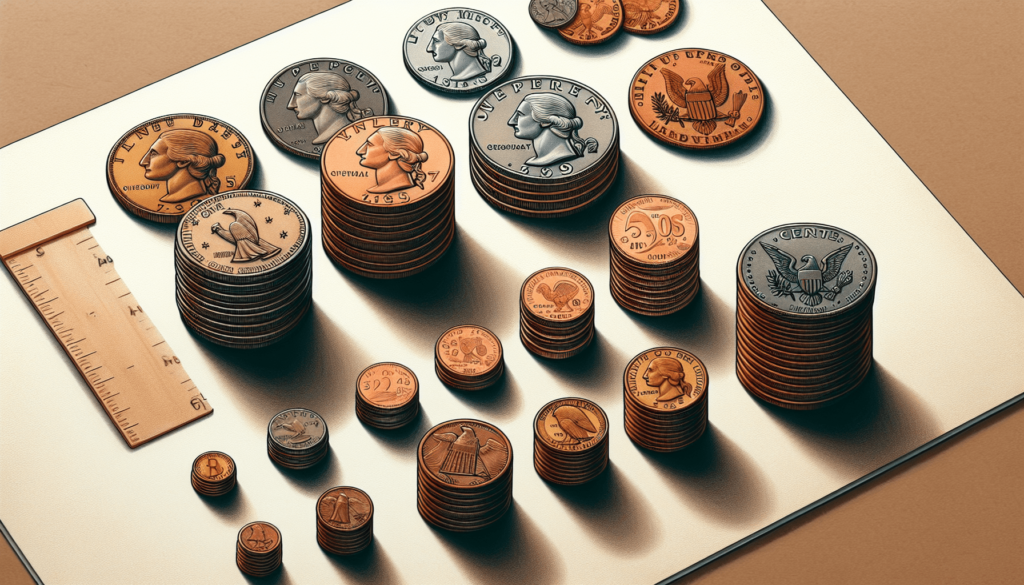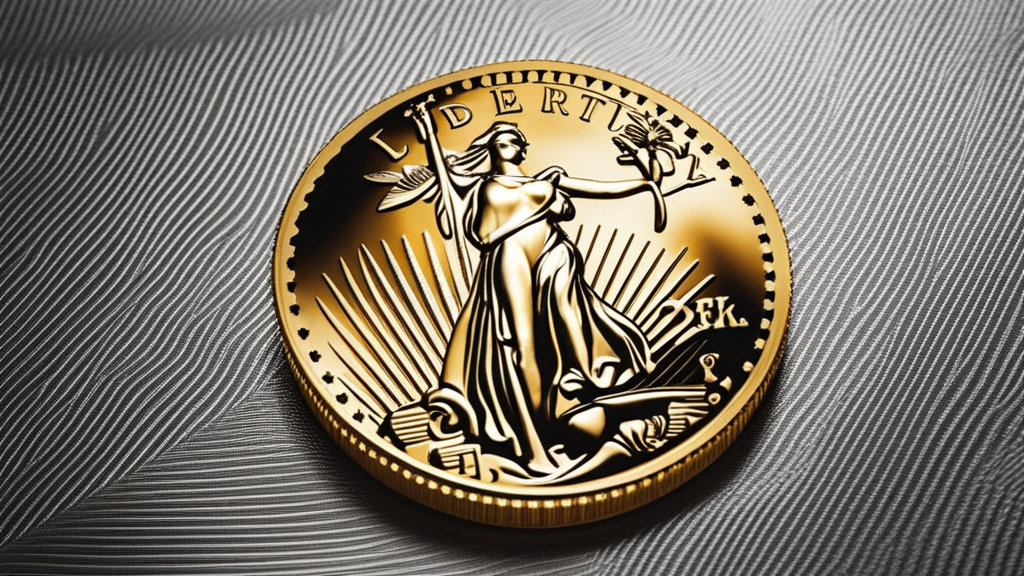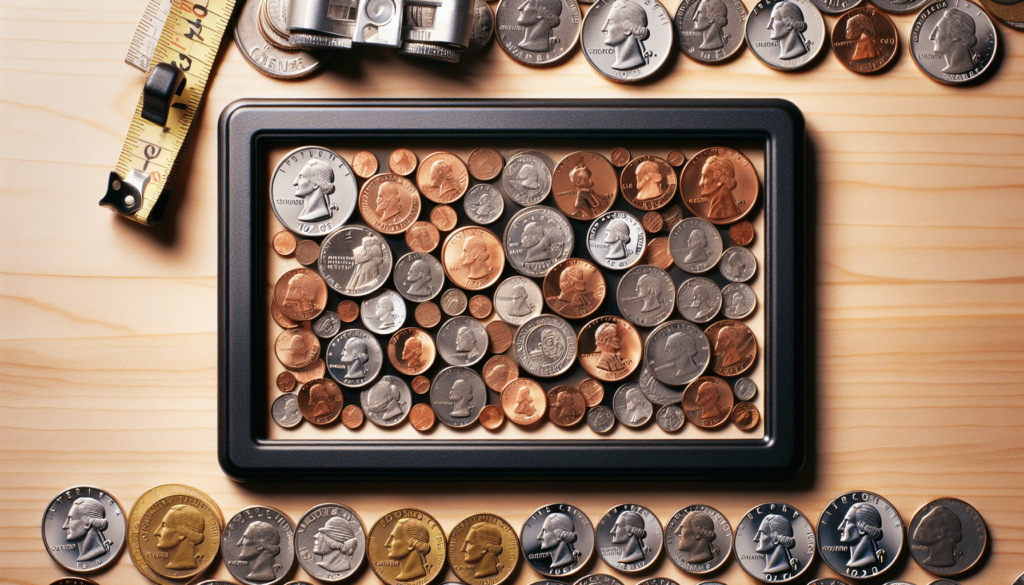So, picture this: you’re at a flea market and you see a box filled with old coins. As a novice coin collector, you’re intrigued and decide to take a closer look. But wait, how do you even know where to begin? Don’t worry, my friend, because I’ve got you covered with “The Ultimate Guide to American Coin Sizes.” This handy guide will break down everything you need to know about the different sizes of American coins, from the dime to the half dollar. So grab a cup of coffee (or your beverage of choice) and let’s dive into the fascinating world of coin sizes!

Understanding American Coin Sizes
Hey there! Have you ever wondered why some coins are bigger than others? Well, understanding American coin sizes can actually be quite important, especially if you’re a collector, a frequent user of coins, or if you just like to impress your friends with random knowledge. In this comprehensive article, we’ll explore the different American coin denominations, the measurements of coins, some fun facts about unusual coin sizes, and even some creative uses for those shiny pieces of metal. So grab a cup of coffee, sit back, and let’s dive into the wonderful world of American coins!
The Importance of Knowing Coin Sizes
Knowing the sizes of American coins might not seem like a big deal at first, but trust me, it can come in handy more often than you think. Imagine you’re grabbing a quick snack from a vending machine and you don’t have exact change. Knowing the size of each coin can make it easier for you to identify which one will fit into the machine. Plus, it’s always helpful to be able to quickly recognize different coins when someone hands them to you, especially if you’re working in a cash-heavy job. So let’s start by taking a look at how we measure the size of coins.
The Diameter of Coins
One of the primary ways we measure American coins is by their diameter. The diameter is simply the distance across the widest part of the coin. For example, a quarter has a diameter of about 0.96 inches, while a dime measures in at roughly 0.71 inches. By knowing the average diameter of each coin, you can quickly gauge whether a coin is a penny, nickel, dime, or quarter just by eye-balling it. Pretty cool, right?
The Thickness of Coins
Another important measurement to consider when it comes to American coins is their thickness. The thickness, also known as the height, tells us how tall or deep a coin is. This measurement is especially helpful when trying to determine if a coin will fit into a specific slot or compartment, like a piggy bank or a coin purse. For instance, a penny is approximately 0.06 inches thick, while a nickel is around 0.08 inches thick. Knowing these measurements can save you the frustration of trying to force a coin into a place it doesn’t belong. Nobody wants to be known as the person who broke their piggy bank, right?
Common American Coin Sizes
Now that we understand the importance of coin sizes, let’s take a closer look at the most commonly used American coins. These are the ones you’re most likely to encounter in your day-to-day life, so it’s crucial to know their sizes.
Quarter
Ah, the mighty quarter! This coin is worth twenty-five cents and is the largest in size among the four most common American coins. With a diameter of about 0.96 inches and a thickness of roughly 0.07 inches, the quarter is definitely hard to miss. Its larger size makes it easier to spot and handle, which is why it’s often the coin of choice for many vending machines and parking meters.
Dime
Moving on to the dime, this little guy is worth ten cents and is the thinnest coin of the bunch. With a diameter of approximately 0.71 inches and a thickness of around 0.05 inches, it’s significantly smaller in both size and value compared to the quarter. Just remember, when you’re dealing with dimes, it’s easy to overlook them, so don’t let them slip through your fingers!
Nickel
Next up, we have the nickel. As the name suggests, this coin is worth five cents, and it’s a bit larger and thicker than the dime. With a diameter of about 0.83 inches and a thickness of roughly 0.06 inches, the nickel is just the right size to make it noticeable without taking up all the space in your wallet. Plus, it’s got that cool ridged edge that makes it stand out from the rest!
Penny
Last but certainly not least, we have the penny. This copper-colored coin is worth a single cent and is the smallest in both diameter and thickness. With a diameter of approximately 0.75 inches and a thickness of around 0.06 inches, the penny might be small in size, but it still holds some value (both literally and sentimentally). So don’t forget to keep an eye out for those pennies on the ground. They might just bring you good luck!
Unusual American Coin Sizes
Now that we’ve covered the basics, let’s move on to some of the more unique American coin sizes. These are the coins that you don’t see every day, but they still hold a special place in the hearts of collectors and enthusiasts.
Half Dollar
Coming in hot with a value of fifty cents, the half dollar is larger and thicker than any of the four common coins. With a diameter of approximately 1.2 inches and a thickness of about 0.08 inches, this hefty coin demands attention. However, you might not come across half dollars very often in your regular transactions since they aren’t as commonly circulated as other coins. But hey, if someone hands you a half dollar, consider it a rare treat!
Silver Dollar
Ah, the silver dollar, a classic coin with a rich history. While silver dollars are no longer in regular circulation, they are still sought after by collectors and coin enthusiasts alike. With a diameter of approximately 1.5 inches and a thickness of about 0.13 inches, the silver dollar is definitely larger than life. Just imagine the weight of that chunk of silver in your hand! Whether you’re lucky enough to stumble upon a vintage silver dollar or you’re admiring a modern commemorative edition, these coins are truly a sight to behold.
Special Edition and Commemorative Coins
Now that we’ve covered the regular American coins and their unusual counterparts, let’s talk about special edition and commemorative coins. These coins often come in unique sizes, distinct from the standard measurements we’ve discussed so far. So if you’re a collector or someone who appreciates the artistry and history behind coins, this section is for you!
Different Sizes for Different Themes
When it comes to special edition and commemorative coins, the sky’s the limit. These coins can come in all shapes and sizes, depending on the theme or occasion they are meant to honor. For example, to celebrate the Apollo 11 moon landing, the United States Mint released a curved coin with a diameter of around 1.5 inches. The design and size of this coin were specifically chosen to mimic the lunar surface. How cool is that? So keep an eye out for these unique treasures, as they add an extra layer of excitement to coin collecting.
The Evolution of American Coin Sizes
Now that we’ve explored the different sizes of American coins, let’s take a trip back in time and delve into the fascinating history of how these sizes have changed over the years. You see, coin sizes haven’t always been the same, and understanding these changes can give us some valuable insights into the economic and cultural shifts that have shaped our nation.
Historical Changes in Size
Throughout American history, coin sizes have gone through various transformations. Back in the 18th and early 19th centuries, coins were generally larger and heavier than what we’re used to today. However, as technology advanced and manufacturing techniques improved, the need for smaller and more practical coins became apparent. So, over time, the sizes of American coins gradually became more standardized and convenient for everyday use.
Reasons for Size Adjustments
There are many factors that influenced the size adjustments of American coins. One of the primary reasons was the need to prevent counterfeiting and fraud. By altering the size, weight, and composition of coins, the government could deter criminals from creating counterfeit copies. Additionally, economic and logistical considerations played a role in determining coin sizes. As the population grew and commerce expanded, it became more efficient to produce smaller, lighter coins that were easier to handle and transport.
Determining Coin Sizes Without Measuring
Okay, so let’s say you don’t have a ruler or caliper handy to measure the diameter or thickness of a coin. No worries! There are still ways to determine coin sizes without breaking out the measuring tools. Here are a couple of tricks you can use:
Comparing Coins
One simple way to estimate the size of a coin is by comparing it to other coins that you know the measurements of. For example, if you have a dime and a quarter in front of you, you can place the unknown coin next to each of them and visually compare its size. By using familiar reference points, you can make a pretty accurate guess without any precise measurements. It’s like playing a game of “Which coin is bigger?”
Using Reference Guides
If you’re serious about coin collecting or just really curious about getting precise measurements, there are various reference guides available that provide the size specifications for different coins. These guides often include detailed images and measurements for both common and rare coins. So if you want to dive deep into the world of coin sizes, consider investing in one of these handy resources. It’ll make you the go-to person for all coin-related questions!
How to Store and Display American Coins
Okay, now that you’ve become an expert on American coin sizes, it’s important to learn how to properly store and display your precious collection. Whether you’re a casual collector or a hardcore numismatist, taking care of your coins will ensure their longevity and maintain their value. Here are a few tips to keep in mind:
Coin Holders and Albums
One of the most popular ways to store and display coins is by using coin holders and albums. These typically come in different sizes and formats to accommodate various coin sizes and collections. Coin holders are clear plastic cases that protect your coins from dirt, moisture, and scratches, while albums provide a more organized and professional display option. So pick the storage method that suits your needs and start showing off your coins with pride!
Preserving Coin Sizes over Time
When it comes to preserving the sizes of your coins over the years, it’s important to handle them with care. Avoid touching the surfaces of the coins with your bare hands, as the oils and acids from your skin can deteriorate their quality. Instead, use gloves or hold the coins by their edges to maintain their pristine condition. Also, keep your coins in a cool, dry place away from direct sunlight to prevent any discoloration or damage. Remember, a well-preserved coin is a valuable coin!
Coin Flipping and Its Origin
Now, let’s take a break from the technicalities of sizes and dive into something a little more whimsical – coin flipping! We’ve all seen it in movies or even used it ourselves to make decisions, but have you ever wondered where this tradition comes from?
The Superstitions Associated with Coin Flipping
Coin flipping has long been associated with superstitions and the idea of leaving important decisions up to chance. It’s often used when two outcomes are equally likely, and the coin toss is believed to provide an unbiased and fair verdict. So the next time you can’t decide between pizza or sushi for dinner, reach for a coin and leave it up to fate!
The Effect of Coin Size on Flipping
Now, here’s an interesting twist! Did you know that the size and weight of a coin can actually affect how it flips in the air? It makes sense when you think about it. A larger, heavier coin will have a different center of gravity compared to a smaller, lighter one. This means that different coins can have different probabilities of landing on heads or tails when flipped. So if you want to up your coin flipping game, consider experimenting with different coin sizes and see if you can predict the outcome!
Fun and Unique Uses for American Coins
We’ve covered a lot of ground when it comes to American coin sizes, but we haven’t even scratched the surface of their versatility. Coins aren’t just for spending or collecting – they can also be used in fun and creative ways!
Craft Projects
One popular way to incorporate coins into your creative endeavors is through various craft projects. From making unique coasters to creating eye-catching mosaic artwork, there are endless possibilities for turning ordinary coins into extraordinary pieces. Just imagine the conversations sparked by a coffee table adorned with a beautiful display of coins. It’s like having a little piece of history right at your fingertips!
Coin Jewelry
Another cool way to showcase your love for coins is by turning them into jewelry. Whether you’re into necklaces, bracelets, or earrings, there’s a wide range of designs and styles that incorporate coins. From classic coin pendants to intricate wire-wrapped creations, coin jewelry adds a touch of elegance and uniqueness to any outfit. Plus, it’s a great conversation starter – who wouldn’t be curious about a necklace made out of real coins?
So there you have it – the ultimate guide to American coin sizes! We’ve explored the importance of knowing coin sizes, the measurements of different coins, the history of unusual sizes, and even some fun and creative uses for these shiny pieces of metal. Next time you come across a coin, take a moment to appreciate its size and think about the stories it holds. After all, every coin has a tale to tell, and now you have the knowledge to listen. Happy hunting and may your pockets always jingle with the sound of success!


